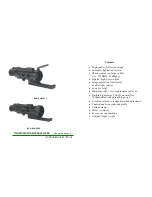
- 12 -
First observations
There is a dust cap in front of the front lens of your telescope. At the same time, press the
two locking buttons slightly inwards and remove the dust cap. The MCX is now ready for
terrestrial observation.
NOTE!
After each observation, the dust cap should be replaced and the power to the telescope
disconnected. Make sure that any trace of dew that may have set in during observation
has evaporated before attaching the dust cap.
With the standard SP 26mm eyepiece, which you previously inserted into the eyepiece
socket, you can achieve a magnification of 56x (MCX-102) or 76x (MCX-127) with your
telescope. Please also read the chapter "What is magnification" on page 15.
All objects that you look at through the eyepiece are aligned upright in the telescope, but
they are imaged upside down. The image orientation is discussed in more detail in the
chapter "Terrestrial observations" on page 15. The tilting mirror (14, fig. 2) must be in the
"UP" position so that you can observe an image in the telescope eyepiece at all (see also
section "Operating the tilting mirror" on page 11!)
In order to experience the maximum viewing pleasure, it is essential that you familiarise
yourself with the features of your MCX telescope and the functions of the handheld
computer described below. Once you've worked through this chapter, your first
observation is a simple earthly object - it should be a few hundred meters away, and it
could be a telephone pole, a street lamp, or a church tower. First locate this object with
the LED viewfinder before viewing it through the MCX telescope. Refer also to chapter
"The LED Viewfinder" on page 12. Practice focusing on the subject with the focus knob (8,
fig. 2) and retrieve it by pressing the arrow keys on your handheld computer (5, fig. 25) in
the middle of the visual field.
Use of the
IV
Fig. 25
The handheld.
f
Summary of Contents for MCX Goto Series
Page 30: ...30 Computerised Handset with LED display VII Fig 35...
Page 39: ...39...





































